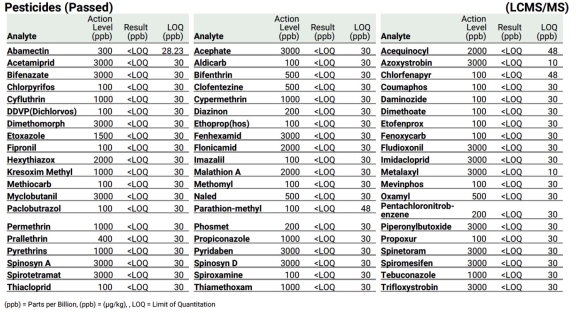If you’ve ever researched how to find a high-quality cannabidiol (CBD) product, there’s likely one tip that continued to pop up—ask for a Certificate of Analysis (a third-party CBD lab report).
Third-party testing is an excellent way to know you’re getting what you paid for and, more importantly, know that the product you’re using is safe, pure, and high quality. But CBD lab reports aren’t exactly user-friendly. If you’re having a hard time reading your CBD lab report or aren’t sure what exactly you should be looking for, you’re not alone.
This guide will break down everything you need to know about how to read a CBD lab report, including its purpose and the most important things to look for when reading one.
How To Read a CBD Lab Report: The Basics
Third-party testing of CBD products ensures purity, consistency, potency, and safety of the product being tested. It provides unbiased test results for transparency and should be done by a lab that is completely unrelated to the company that it’s testing for.
A CBD lab test should test for things like cannabinoid and terpene profile, potency, pesticides, herbicides, heavy metals, microbiological contaminants, and residual solvents.
Typically, you can find the CBD lab report either on the company’s website or via a QR code printed on the product packaging itself.
What To Look for When Reading a CBD Lab Report
First things first—what form of CBD is your product? Is it full-spectrum, broad-spectrum, or isolate? This will help you determine exactly what to look for in your lab report.
For hemp-derived CBD products, you should look for the following:
-
The amount of CBD: For oils and tinctures this number is typically provided in units of mg/mL. Take this number and multiply it by the number of mL in your bottle. This should be close to or greater than the number listed on the product label. For example, this CBD lab report for a 1200 mg CBD oil shows 90.515 mg of CBD per mL. It’s a 15 mL bottle, so multiplying those together we get 1,357.73 mg CBD in the entire bottle.

-
The amount of total THC: For hemp-derived full-spectrum CBD products, make sure there's less than 0.3% total THC. For broad-spectrum and isolate products, this number should be 0%.

-
Additional cannabinoids and terpenes: Full- and broad-spectrum products should contain additional cannabinoids, such as CBC, CBDV, and CBG, as well as terpenes. Make sure the CBD lab report reflects this. Terpenes will likely have their own section in the report, and additional cannabinoids can be found in the potency section.

-
Residual solvents: Residual solvents are organic volatile chemicals that are used or produced during the extraction process which are undesirable in CBD products as they can be harmful if consumed. This section should say “passed” or “pass” if none were detected. In the “Results” column, it should either say “< LOQ” (Limit of Quantitation) or “ND” (Not Detected) for each residual solvent that was tested for.

-
Heavy metals: Make sure no heavy metals were detected during testing. Heavy metals can cause serious short- and long-term health effects if consumed. The section should say “passed” or “pass” if none were detected. In the “Results” column, it should either say “< LOQ” or “ND” for each heavy metal that was tested for.

-
Mycotoxins: Mycotoxins are produced by molds and fungi and are a known risk in the food safety industry and have been linked to kidney damage, liver damage, immune suppression, and reproductive disorders. Check that no mycotoxins were detected during testing. The section should say “passed” or “pass” if none were detected. In the “Results” column, it should either say “< LOQ” or “ND” for each mycotoxin that was tested for.

-
Microbiological contaminants: No microbiological contaminants should be detected during testing. Microbiological contaminants include bacteria, viruses, fungi, mold, and toxins and can cause serious illness if consumed. The section should say “passed” or “pass” if none were detected. In the “Results” column, it should either say “absence” or “ND” for each microbiological contaminant that was tested for.

-
Pesticides: Pesticides are chemicals that are often sprayed on the hemp plants or applied to the soil to prevent pest problems. However, if pesticides remain in the final product, exposure or consumption of pesticides can cause a range of health problems. There should be no pesticides detected during testing. The section should say “passed” or “pass” if none were detected. In the “Results” column, it should either say “< LOQ” or “ND” for each pesticide that was tested for.

-
Herbicides: Herbicides are chemicals used to manipulate or control undesirable vegetation. Similar to pesticides, herbicides can cause serious health problems if consumed. Make sure no herbicides were detected during testing. The section should say “passed” or “pass” if none were detected. In the “results” column, it should either say “< LOQ” or “ND” for each pesticide that was tested for.

Need More Guidance on How To Read a CBD Lab Report?
At Feals, we’re dedicated to providing pure, potent, safe, and high-quality CBD products. In addition to our internal testing, all of our products are third-party tested. Our commitment to transparency and quality means you can simply scan the QR code on your product’s packaging and view the detailed test results or you can view batch results here.
If you still have questions on how to read a CBD lab report, our CX team would be more than happy to help you out. Just give them a ring or shoot them an email.
These statements have not been evaluated by the Food and Drug Administration. This product is not intended to diagnose, treat, cure, or prevent any disease. This article is for informational purposes only. It is not, nor is it intended to be, a substitute for professional medical advice, diagnosis, or treatment and should never be relied upon for specific medical advice.

